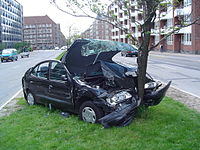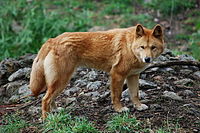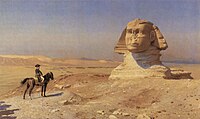| Revision as of 22:04, 1 November 2008 edit69.120.245.249 (talk) →30 years A.H← Previous edit | Revision as of 03:30, 4 November 2008 edit undo71.57.3.106 (talk) →Cities featuredNext edit → | ||
| Line 131: | Line 131: | ||
| *], {{GER}} | *], {{GER}} | ||
| *], {{UK}} | *], {{UK}} | ||
| *], {{USA}} | *], {{USA}}(ONE SCENE ONLY) | ||
| *], {{USA}} | *], {{USA}} | ||
| *], {{USA}} | *], {{USA}} | ||
Revision as of 03:30, 4 November 2008
2008 TV series or program| Aftermath: Population Zero | |
|---|---|
| Country of origin | |
| No. of episodes | 1 |
| Production | |
| Running time | 120 minutes |
| Original release | |
| Network | The National Geographic Channel |
| Release | 9 March, 2008 |
Aftermath: Population Zero (also Aftermath: The World After Humans) is a special feature produced by Cream Productions and shown on the National Geographic Channel in which scientists and others speculate what the earth, animal life, and plant life might be like if humanity no longer existed, as well as the effect that humanity's disappearance would have on the artifacts of civilization. The program is similar to the History Channel show Life After People and debuted at 8:00 P.M. ET/PT on Sunday, March 9 2008.
Timeline
The story begins on Friday, June 13, in an unspecified year. The nature of the show and the appearance of certain vehicles suggest that it takes place in 2008.
Day 1 A.H. (after humans)

- Empty cars and other vehicles swerve off the roads and crash, causing multiple accidents all across the globe. Those that don't burn out as a result continue to release exhaust into the air until their fuel supplies run out. Aeroplanes fall from the sky. Some crash just some minutes after takeoff when their crews disappear, whereas others at high altitudes and with their fuel tanks full continue flying for hours. Trains derail.
- Coal plants run out of coal. Many cities around the world go out. Some buildings supplied with energy by them, such as Las Vegas casinos, fall into darkness. Others switch to generators which, in turn, get their energy from other sources (windmills, dams): the demand proves to be too much for what these plants can provide and produces mass power blackouts. Within just 85 minutes, only nuclear power plants continue working.
- Chlorine tanks, which need to remain cold, heat up until release valves are activated, sending the gas into the surrounding environment. Many animals die of suffocation. Also, LNG tanks begin to fail, causing many fires and explosions.
Day 3 to day 7 A.H.
- Big Ben rings for the last time.
- Pet dogs and cats exhaust all the food stored in their owners' homes and break out to search for more in the streets.
- Water pumps fail, leaving sewage treatment plants useless and polluting rivers and lakes.
- Without water available in farms, animals (especially cows) break out to find other sources in the countryside.
- Zoo animals escape through useless electric fences and roam free.
- Migration is safer for birds now, as electric lights do not confuse them anymore.
- As days pass, dogs eat all easily-available food and begin to fight amongst each other for supremacy. The bigger dogs make packs and attack the small ones to eat them. Within a week, all toy dogs disappear from Earth.
- Security measures in power plants fail. Their cooling water starts to heat up and evaporate.
Day 10 A.H.

- Hungry dogs from cities flee to the countryside.
- As there isn't anybody to milk them anymore, dairy cows have their udders infected and die. Beef cattle, on the other hand, survive and form herds that thrive in places like the North American Great Plains.
- The last domestic chickens are exterminated by predators.
- Spent nuclear fuel for nuclear power plants is generally stored in pools in on-site facilities. Since this water is not replenished, the heat of the fuel rods boils it away and the steam pressure causes the storage facilities to explode. The resulting nuclear disasters spread fallout over large areas. Radioactive clouds cross the skies and rain carries the radiation to the ground. Most plants and small animals within the affected zones die. The bigger ones (like deer) flee to unaffected regions - not because they notice the radiation, but because of the lack of food.
- Mice take over abandoned supermarkets, where their population explodes thanks to the abundance of food there. This pattern will continue for the next few months until their population is regulated again by the reduction of food and the action of predators like cats.
- Squirrels, raccoons, coyotes and skunks begin to colonize human buildings.
3 Months A.H.
- Radiation disappears from the air.
- In cities, air quality and visibility is improved.
- Packs of feral dogs roam the countryside. Desperate for food, they attack anything - even escaped elephants. But they don't have any success in this case. Without humans, elephants have no real predators anymore.
6 Months A.H.
- Winter begins in the Northern Hemisphere. Zoo animals that cannot survive it, like elephants, must migrate to southern latitudes or die.
- Without artificial heating, cockroaches die by the millions in cold houses.
- Animals from the forests like raccoons and skunks seek refuge in human homes to spend winter. During their stay, they cause further damage to the abandoned furniture.
10 to 12 months A.H

- In the spring, trees nearer to power plants can't produce buds, but those farther out recover.
- Spring rains wash away the radioactive particles from the surface and carry it further into the ground, cleaning plants and objects.
- Meanwhile, new plants and trees remove the excess CO2 from the atmosphere left by cars.
- Without hunting season, animals breed undisturbed. Some species in areas with no natural predators, like the white tail deer, see population booms and expand their distibution to new areas, including former cities.
- Moss starts to grow over roads.
3 to 15 years A.H
- Roads appear degraded and cracked by the ice of multiple winters with no maintenance. Their surfaces are covered by moss and grass grows in the cracks.
- New trees grow in home gardens.
30 years A.H
- Deviated by solar winds, artificial satellites return to Earth in the form of shooting stars. Some of their pieces made it to the ground and start some fires.
- House roofs collapse, allowing trees to grow in their interior.
- Scoured by hurricane after hurricane, the East Coast of the United States is slowly cleaned of buildings. Florida is completely swept away.
- In the ocean, the remains of former ships serve as foundations for the formation coral reefs.
- Cereal fields are turned into grasslands or overrun by expanding forests. The same happens to cities as grass and trees take root on streets and buildings.
- Panes of window glass fall from buildings to the streets.
- Birds of prey make their nests and hunt rodents in skyscrapers.
- Paint is weathered away after years of exposure to rain. Metal in cars and other human structures is exposed to oxidation and disintegration.
- Concrete begins to collapse.
60-120 years A.H

- Skyscrapers around the world begin to collapse.
- Sea life has completely recovered from overfishing and is thriving.
- Though there are still dogs, dog breeds do not exist anymore, erased by generations of free reproduction. Many of the feral dog breeds have died out due to neutering, resulting in a genetic bottleneck in the remaining dogs. Survivors mate with wolves.
- In Europe, the largely decreased wolf population expands into the countries where it was completely exterminated, like Germany. Upon reaching the ruins of cities, wolves come into contact with feral dogs living there, competing with them for food or breeding with them, erasing the last traces left of domestication.
150 years A.H
- Winters are colder than in the last days of the human race.
- Remains of ships and bridges form dams in the Thames, flooding the ruins of London and turning the British capital back into the swamp it was before Roman times.
- Imperial Valley, once the biggest producer of fruits in the United States, returns back to a sandy desert.
- Dry winds still maintain most of Las Vegas buildings intact. They serve as a refuge for vultures and desert lizards now.
200 years A.H
- Most of the dams on the Colorado River are destroyed due to excessive water pressure. The Hoover Dam survives, but water passes over it forming a cascade. For the first time in centuries, the Colorado River once again reaches the Sea of Cortez and gives birth to a vast estuary full of animal life.
- The coast of Louisiana is reshaped.
- Old codfish reach six feet long.
- All whale species have recovered to their pre-human populations. Without the interference of noisy naval alarms, they can hear the mating calls of other whales from 2000 miles away.
- Remains of large ships appear on beaches all over the world, after two centuries of errant journeys over (and under) the waves.
- The excess of CO2 in the atmosphere is completely eliminated by plants and trees.
230 years A.H

- The upper half of the Eiffel Tower collapses and falls into the new Seine River's marsh. Thousands of feral pigs (descendants of both domestic pigs and wild boars) live under the Tower's legs and are regularly hunted by wolves.
- The right arm of the Statue of Liberty falls to the ground. The head follows some time later.
- The eastern half of North America is entirely covered by thick forests with trees that grow up to 90 meters tall.
- Human structures still survive under forest humus. From time to time rains and rivers wash humus away uncovering concrete beams, plastics, cellphones and stainless steel objects.
- Tens of millions of bisons, cattle and horses make up gigantic herds in the Western North American plains.
- The Great Sphinx of Giza is buried again in the sands of the Sahara.
500 years A.H
- Forests recover the state they had 10000 years ago.
1000 years A.H
- The Eiffel Tower has lost all but its four legs.
- The Statue of Liberty has fallen to pieces and only its pedestal still stands.
25000 years A.H
- Earth enters a new Ice Age and glaciers expand south covering most of the Northern Hemisphere. Last traces of New York City are completely erased.
- However, objects and other evidence left by Moon exploration missions survive intact for not only thousands, but millions of years after mankind vanished. They will be the last legacy of the human race....
Cities featured
- Toronto,
 Canada
Canada - Niagara Falls,
 Canada
Canada - Paris,
 France
France - Rome,
 Italy
Italy - Berlin,
 Germany
Germany - London,
 United Kingdom
United Kingdom - Chicago,
 United States(ONE SCENE ONLY)
United States(ONE SCENE ONLY) - New York City,
 United States
United States - Las Vegas, Nevada,
 United States
United States - Tokyo,
 Japan (in pre-Human extinction scenes only)
Japan (in pre-Human extinction scenes only)
Comparison to Life After People
As with the similar special feature on the History Channel, Life After People, Aftermath does not explain how humanity disappeared, but rather what would happen to the Earth after we disappeared. Also, both series depicts the possible fates of famous pieces of infrastructure and buildings. It, too, uses CGI dramatizations to depict the possible fate of such icons as The Statue of Liberty and, in both programs, the Eiffel Tower and Hoover Dam. However, it does not emphasize this as much as Life After People does, following much more closely the effects on the natural world and its recovery after mankind departs the scene.
In addition, unlike Life After People, Aftermath depicts what would happen if various modes of transportation—such as automobiles, planes, and trains— are abandoned in mid-motion when their passengers and operators instantly disappear, not unlike the Rapture in Christian eschatology. It also shows that humans disappear instantly, not a few at a time.